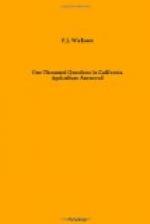Tree Planting on Coast Sands.
I wish to plant fruit trees on a sandy mesa well protected from winds about a mile from the coast. The soil is a light sandy loam. I intend to dig the holes for the trees this fall, each hole the shape of an inverted cone, about 4 feet deep and 5 feet across, and put a half-load of rotten stable manure in each hole this fall. The winter’s rains would wash a large amount of plant food from this manure into the ground. In March I propose to plant the trees, shoveling the surrounding soil on top of the manure and giving a copious watering to ensure the compact settling of the soil about and below the roots. The roots would be about a foot above the manure.
On such a light sandy soil you can use stable manure more safely than you could elsewhere, providing you have water handy to use if you should happen to get too much coarse matter under the tree, which would cause drying out of the soil. If you do get plenty of water to guard against this danger, you are likely to use too much and cause the trees to grow too fast. Be very sure the manure is well rotted and use one load to ten holes instead of two. Whether you kill the trees or cause them to grow aright depends upon how you use water after planting.
A Wrong Idea of Inter-Planting.
What forage plant can I grow in a newly planted orchard? The soil is on a gently inclined hillside — red, decomposed rock, very deep, mellow, fluffy, and light, and deep down is clayish in character. It cannot be irrigated, therefore I wish to put out a drought-resisting plant which could be harvested, say, in June or July, or even later. I find the following plants, but I cannot decide which one is the best: Yellow soja bean, speltz, Egyptian corn, Jerusalem corn, yellow Milo maize, or one of the millets. What do you think?
Do not think for a moment about planting any such plant between orchard trees which are to subsist on rainfall without irrigation. Your trees will have difficulty enough in making satisfactory growth on rainfall, and would be prevented from doing so if they had to divide the soil moisture with crops planted between them. The light, deep soils which you mention, resulting from decomposed rock, are not retentive enough, and, even with the large rainfall of your region, may require irrigation to carry trees through the latter summer and early fall growth.
What Slopes for Fruit?
I want to plant some apples and berries. One man says plant them on the east or south slope of the hill and they will be ripe early. Another man says not to do that, for when the sun hits the trees or vines in the morning before the frost is off, it will kill all the blossoms, and as they would be on the warm side of the hill they would blossom earlier and there will be more frosts to injure them. I am told to plant them on the north or west side of the hill, where it is cold, and they will blossom later and will therefore have less frosts to bother them, and the frost will be almost off before the sun hits them in the morning.




